TIMEPASS
I don't know who I am, but I know who I am not
Thursday, June 29, 2006
Tuesday, June 27, 2006
Not One Less
Let me briefly give the story : The film is set in the present, in a small village in Hebei province. When teacher Gao is called home as his mother is not well, the village mayor hires Wei Minzhi as Gao’s temporary replacement. Thirteen-year-old Wei is barely older than her students. she does not have any teaching experience. But her stubbornness and determination know no bounds. Intially teacher Gao does not like the idea of keeping Wei as substitute because he is afraid that the students will leave school due to inexperienced Wei. The Mayor tells that it is impossible to find another substitute as nobody is willing to come to this remote village. Teacher Gao at last agrees and allows Wei to stay and take class for a period of one month.

The school is a one room classroom with a black board and some desk and benches. There is a room attached to the classroom which is the work place, kitchen and bedroom of the teacher. Teacher Gao gives 30 chalks (one for each day) and asks her to daily write a text on the blackboard each day and ask the student to copy it.The conversation between Gao and Wei is very interesting and is one of the highlight of the movie. The Mayor and Gao though unsure, promises Wei that she will given 50 yuans if all the 28 students are there when Gao returns after one month.

Trip to Shravanabelagola
Last week myself and my wife decided to visit Shravanabelagola, the ancient statue of Lord Gomateshwara (Bahubali) which is said to be the tallest monolith in the world. I consulted my office friends and also searched on internet to know about the route and the history of shravanabelagola and the bus timings. We decided to go on a Saturday as it was my weekly off-day at office and my wife planned to take leave.
On Saturday early morning we woke up early at 4.30 am, packed the travel accessories and got ready for the trip. I was very much excited as we will be going out of this busy city,concrete jungle, traffic jams for few hours. The previous night it had rained heavily and it was still cloudy in the morning. We started from house on my bike at 5.30 am, reached Majestic Bus Station(I like to ride at early morning hours as this is the only time you can get clean and empty roads in Bangalore), parked my bike at pay-n-park. I was told that we need to catch a bus to Hassan and get down at Channarayanapatna and from there need to catch another bus to Shravanabelagola. When we went inside the bus stand and inquired with the Driver of Hassan going bus, he informed that there is a direct bus to Shravanabelagola. It was very nice to hear that and we got a direct bus to Shravanabelagola which was to depart at 7.00am. We were the first passenger to get inside the bus. As there was still time left for the bus to depart, so we went and bought some snacks. Soon the bus got filled with passengers and the bus started at sharp 7.00am (I was surprised to see the punctuality).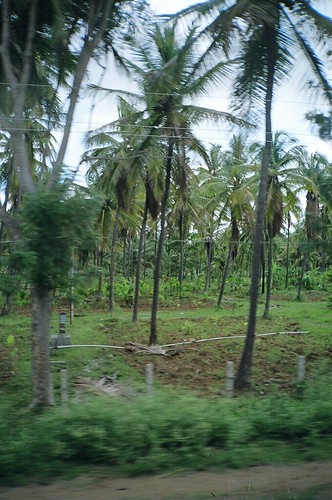 The travel was very pleasant. The road was very good with big trees on both sides of the road. The sun was playing hide and seek in the overcast sky. The greenery outside was very refreshing for the eyes. Coconut and sugarcane plantations were there outside. My mind went back to my native on watching the natural beauty outside. The bus halted at a hotel near Adi chinchinagiri Medical college for 15 minutes. Both of us just had a coffee from there. I noticed on the way that almost all the houses had dish antenna.
The travel was very pleasant. The road was very good with big trees on both sides of the road. The sun was playing hide and seek in the overcast sky. The greenery outside was very refreshing for the eyes. Coconut and sugarcane plantations were there outside. My mind went back to my native on watching the natural beauty outside. The bus halted at a hotel near Adi chinchinagiri Medical college for 15 minutes. Both of us just had a coffee from there. I noticed on the way that almost all the houses had dish antenna.
We reached Shravanabelagola at around 10.15am. I asked the driver about the last return bus to Bangalore. He informed that the last bus depart from Shravanabelagola at 3.00pm. From the Bus Stand I could see the Vindhyagiri Hill and the temple over it. we could see people climbing the steps as small ants moving. Shravanabelagola is a small town and has many small shops at the foothill. We went to a hotel (Raghu Hotel) which is near the entrance gate to Vindhyagiri Hill and had Masala dosa, vada and a tea (and it was really good). I could see that most of the people were from the West and North India.
Shravanabelagola is a historical and one of the most important Jain Pilgrimage centre and the 9th Century Statue of Lord Gomateshwara is on the top of the vindhyagiri Hill. The Vindhyagiri is said to be one single solid rock and the 58 feet tall statue of Bahubali is said to be carved out of a single rock. There are two main hills - Vindhyagiri and Chandragiri. The sharavanabelagola town and a pond (Kalyani pond) are inbetween the two hills.
After having our breakfast from the hotel we started our journey to the top of the Vindhyagiri hill. At the entrance it was written that footwears are not allowed, so we handed over our footwear at footwear counter. Steps are carved on the hill to climb till the top. There are approximately 630 steps. There are some special palanquins available for people who are not able to climb the hill on foot. It is a wonderful experience to climb barefoot because as you go up the view of the town and the vast distant hill and lands is indescribable. As were halfway, we could see the temple on the adjacent temple chandragiri and the beautiful pond below. Lot of coconut trees were visible. I took some snaps of the mandapams and temples and the carvings on the rocks. There were some scriptures written on the rocks, I could not make out the language. I could see a lot of pictures of Hindu God and Goddess on the rocks.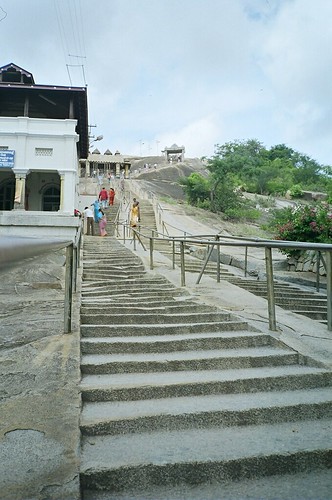
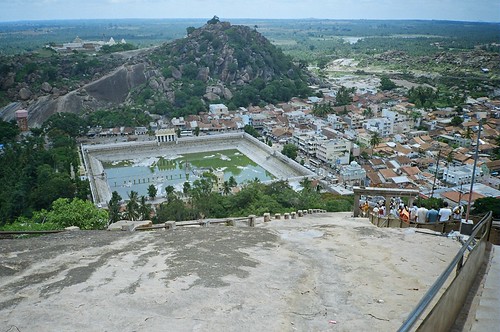
We then reached the top of the hill and entered the temple and got the glimpse of the Bahubali statue in full. I looked at the statue and felt that the vast blue sky was the perfect background for that statue. The statue is a marvel of architecture with its simplicity. The statue is made thousand of years ago and was made with primitive tools (In 981 A.D., Chavundaraya, the minister of the Ganga King Rachamalla had this statue carved). I was thinking how perfect the architect would be because a single mistake of the tool might have made them go in search of another hill and rock and restart the job.
Gommateshvara, or Bahubali, is the son of Adinath, the first Jain tirthankara. He won everything from his brother and could have become an emperor; and yet, in utter selflessness he returned everything to the brother. Bahubali is the ideal man who conquers selfishness, jealousy, pride and anger.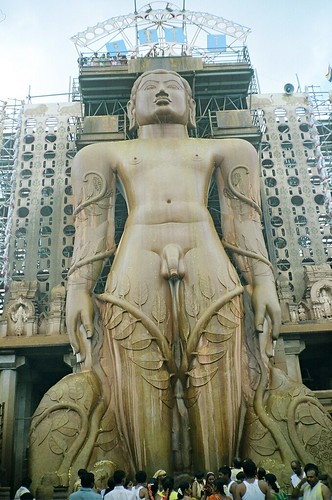
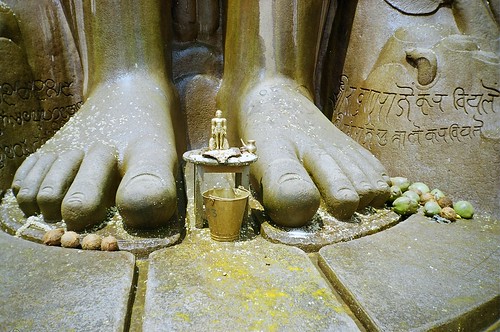
We sat there at the temple and I was looking at the face of the statue. There was a small smile on the lips of the statue and the eyes were staring at eternity. I was thinking how long has this statue been standing there facing all the rain, storms and still staring straight. Many devotees were performing Abhishekam on the statue with Milk, turmeric, flower etc and it was a great sight. We sat there for sometime. When we were about to leave, I had a strange feeling, I was thinking that the statue will be there in the posture for thousand of years and people will keep comming, sit, pray and go back and they will die.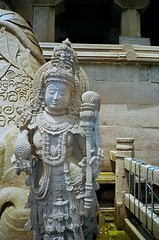

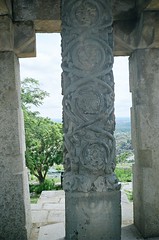
We then climbed down and it was afternoon, the sun was really getting hot. We climbed down the hill very fast. Had some juices to beat the thirst and heat and then we climbed the next hill -Chandragiri hill. It is comparatively smaller hill but there are a lot of temples on the hill. We rested for a while under a huge rock.
This hill got its name from Chandragupta Mourya, the 300BC Indian emperor, who left his throne and walked all the way to the hill from his capital at Magadha. He spent his last days in a cave on the top of the hill.Then we walked to the ancient Jain temple nearby. I was surprised to read in a board placed there that this temple is 2300 years old. I think this would be the oldest building I have ever seen. We walked through the temples and climbed down. It was already 1.30pm. We visited another Jain ashram nearby. I purchased a book on history of Shravanabelagola and Lord Gomateshwara. The visit made me more curious about the Jain religion and there culture. Though my wife got tired of climbing the hill, she very much liked the trip.
We came back to Bus station as the last bus to Bangalore was at 3.00 pm. At Bus station we saw a lot of college students and they were making a lot of noise. Afterwards we came to know that one among them was leaving the college and so all his friends has come to see-off him. The bus came on time and we got seated. As the bus was about to leave I saw that the college students were getting very emotional as their friend was departing, some of them were crying, the boy who was leaving was hugging each and every friend.
Inside my mind I felt that I am leaving this beautiful place with a lot of memories and outside the college students were giving emotional farewell to the friend.
On the way back it rained inbetween and I watched the rain drenched scenic beauty outside. We reached Majestic Bus station at 6.30pm. We took the bike and returned home. Again we were held up in traffic jam, vehicle horns, traffic lights, crowds and lot of noises. I was thinking of the peaceful moment a few hours earlier. I was tired but inside I was planning for my next trip.
". . .travel is more than the seeing of sights; it is a change that goes on, deep and permanent, in the ideas of living." -Miriam Beard
Monday, June 26, 2006
"Strength is infectious"
I liked these line from Hritik Roshan's interview :
"Strength is not one that makes you feel stronger than others around you. True strength is actually infectious. It makes others around you feel strong. That's the concept of strength that I believe in and that's the strength that Krrish has and stands for. "

A short Story..!!!!
Read and liked the below story so added it here :
A water bearer in China had two large pots, each hung on the ends of a pole which he carried across his neck. One of the pots had a crack in it, while the other pot was perfect and always delivered a full portion of water. At the end of the long walk from the stream to the House, the cracked pot arrived only half full.
For a full two years this went on daily, with the bearer delivering only one and a half pots full of water to his house. Of course, the perfect pot was proud of its accomplishments, perfect for which it was made. But the poor cracked pot was ashamed of it's own imperfection. And miserable that it was able to accomplish only half of what it had been made to do.
After two years of what it perceived to be a bitter failure, it spoke to the water bearer one day by the stream. "I am ashamed of myself, and I want to apologize to you. I have been able to deliver only half my load because this crack in my side causes water to leak out all the way back to your house. Because of my flaws, you have to do all of this work, and you don't get full value from your efforts," the pot said.
The bearer said to the pot, "Did you notice that there were flowers only on your side of the path, but not on the other pot's side? That's because I have always known about your flaw. So I planted flower seeds on your side of the path, and every day while we walk back, you've watered them. For two years I have been able to pick these beautiful flowers to decorate the table.Without you being just the way you are, there would not be this beauty to grace the house?
Moral: Each of us has our own unique flaws. We're all cracked pots. But it's the cracks and flaws we each have that make our lives together so very interesting and rewarding. You've just got to take each person for what they are, and look for the good in them. Blessed are the flexible, for they shall not be bent out of shape.
Remember to appreciate all the different people in your life. Each one of them can leave an impact if we are able to see their uniqueness
Trois Couleurs - ROUGE
Continuing with the Kieslowski's Trilogy, let me now write about the third part 'RED'. (I could not get the second part -White). RED(France/1994) : The concluding part 'RED' stands for 'Fraternity' on French flag.Red is the color of love and blood - life and death. This is the most mysterious and complex movie in the trilogy. Valentine (Irene Jacob) is a model whose new advertisement is going to be displayed on the main billboard in the crossroad in Geneva. One day while returning from her work Valentine accidentally knocks down a German shephard with her car. She takes the dog and track down the owner of the dog. The dog belongs to a retired judge (Jean-Louis Trintignant) who is living in seclusion and spends his time tapping the phone conversation of his neighbours using his shortwave radio. A strange kind of bonding develops between Valentine and the judge. There is also a parallel story of a recently graduated law student Auguste (Jean-Pierre Lorit) and his girlfriend. In the later part of the movie we come to know that the young judge, Auguste's experiences are similar to the one that happened to the retired judge 30 years ago. Kieslowski sets up a visual connection between them from the very beginning of the film.
RED(France/1994) : The concluding part 'RED' stands for 'Fraternity' on French flag.Red is the color of love and blood - life and death. This is the most mysterious and complex movie in the trilogy. Valentine (Irene Jacob) is a model whose new advertisement is going to be displayed on the main billboard in the crossroad in Geneva. One day while returning from her work Valentine accidentally knocks down a German shephard with her car. She takes the dog and track down the owner of the dog. The dog belongs to a retired judge (Jean-Louis Trintignant) who is living in seclusion and spends his time tapping the phone conversation of his neighbours using his shortwave radio. A strange kind of bonding develops between Valentine and the judge. There is also a parallel story of a recently graduated law student Auguste (Jean-Pierre Lorit) and his girlfriend. In the later part of the movie we come to know that the young judge, Auguste's experiences are similar to the one that happened to the retired judge 30 years ago. Kieslowski sets up a visual connection between them from the very beginning of the film.
The performance of Irene Jacob and Jean-Louis Trintignant is superb. The innocence on the face of Irene Jacob is amazing.
However, what I liked most is the conclusion. Red is a closure of sorts of the trilogy. So when we see all the six main characters from the trilogy come together in the end.
The Color Red is used very artistically, the red jeep, the red billboard,Valentine's red dress, etc.
The cinematography is by Piotr Sobocinski and his work here earned him an Oscar nomination. The background score is also superb.
It is heard that, Kieslowski was exhausted from having completed the trilogy in a staggered, accelerated time frame (at one point, he was editing Blue, shooting White, and writing Red concurrently).
Just imagine this opening shot by Kieslowski of the movie 'Red' - A hand picks up a phone and dials a number. The camera then follows the chord of the phone to the wall, then to the street, into and across the English channel, and then to another phone in Geneva. There is a simultaneous conversation going on in the background. The scene itself expresses the connection people make between them.
Watch the trilogy and the way you see and interpret colors and life will not be same again.

Trois Couleurs - BLEU
I finished watching two movies (Blue and Red) out of Krzysztof Kieslowski's trilogy Bleu, Blanc, Rouge. I am restricted by the lack of words that I know of or am aware of to write about the work of Kieslowski. It is very difficult to write about the works in words, one has to feel and observe these movies. These movies are around 13 years old but even today it looks fresh. The special features in the DVD helped me in getting more insight into these movies. One can watch these movies innumerable times and will never get bored, infact each time you watch you will see something new in it. Krzysztof Kieslowski's trilogy,
Trois Couleurs: Bleu, Blanc, Rouge offers a trio films that rather doggedly refuse to explain themselves, though on the surface relate three tales of modern French society. The three colors are from the French flag (Blue stands for Liberty, White for Equality and Red for Fraternity), and their stories in some way reflect the meaning of each of the colors. Blue (France/ 1993) : The first and most difficult of the films is Bleu (Liberty).Blue stands for liberté, or liberty,in the French flag. The luminous Juliette Binoche stars as Julie, whose life is shattered when her famous-composer husband and their daughter are killed in an auto accident. Julie decides to deal with the tragedy by attempting to completely wipe out the period of her marriage from her life, selling their country home, taking back her maiden name and moving into a flat in Paris. But she finds that dismissing the past is harder than she imagined. She is haunting by the symphony her husband had been commissioned to write for the country, and there are hints that he may have been a fraud. There are also hints that the marriage might not have been all it appeared to be on the surface, and when Julie makes a startling discovery about her husband, she finally comes to grips with her own liberty.
Blue (France/ 1993) : The first and most difficult of the films is Bleu (Liberty).Blue stands for liberté, or liberty,in the French flag. The luminous Juliette Binoche stars as Julie, whose life is shattered when her famous-composer husband and their daughter are killed in an auto accident. Julie decides to deal with the tragedy by attempting to completely wipe out the period of her marriage from her life, selling their country home, taking back her maiden name and moving into a flat in Paris. But she finds that dismissing the past is harder than she imagined. She is haunting by the symphony her husband had been commissioned to write for the country, and there are hints that he may have been a fraud. There are also hints that the marriage might not have been all it appeared to be on the surface, and when Julie makes a startling discovery about her husband, she finally comes to grips with her own liberty.
In one of the scene midway of the movie we see Julie visit her mother who is in a rest home. She doesn't recognize Julie and is busy watching Television. On television in front of them are images of older people bungee jumping against a soft blue sky. The image of bungee jumpers can be compated to Julie as both are trying to Liberate themselves.
The usage of the color Blue in the entire movie is spellbinding - blue-glass-beads chandelier and the blue light patterns that these glass-beads throw on Julie's face, the blue of the swimming pool, the blue room, the blue-tinged lighting of the outside as seen from Julie's hospital window, will stay with you forever after watching the movie.Kieslowski uses suffering as a means to illustrate the theme of liberation. Julie's periodic swims in the pool (which appears blue at night), completion of her husband's unfinished symphony (with a blue pen), and transfer of their country estate to his mistress (who is expecting a boy) are all symbolic acts of closure. "There is freedom in having nothing. There is also freedom in losing everything".
Julie is a complex character who is generous to a fault at times and yet shockingly cruel, when she leaves the neighbor's cat on a litter of mice that she is scared of. Yet, even at that very moment she feels guilty of her deed. It does not stop her though. The complexity of the character is so real, as real as perhaps me and you and hence easy to identify with. When Julie refuses to be party to a signature campaign against a neighbor whose occupation of a sex-worker shames and irks the other neighbors, a point is made about equality, subtly, without very many dialogues and preaching, yet firmly so. It's further stressed on when Julie finds an unlikely friend in this girl. A sex-worker and her occupation does not make her any less than anyone else. Visually, the movie is beautiful with some stunning close-up shots of Julie's eyes.
Juliette Binoche performance surely enhances this beauty(Kieslowski reportedly didn't want to make the film if he couldn't get her). From the body language one can make out the pain, The corner of her mouth slightly quivers as she traces her daughter's casket through a television set. Her body goes limp when she approaches the doorway of her husband's study. Her gaze turns protective and territorial when a neighbor touches a blue crystal mobile that once hung in her daughter's room.
The film is blessed with gorgeous cinematography by Slawomir Idziak: every frame of this film is a knockout. The intriguing music score and fade-to-black editing provide the film with an interesting sensation.
For a particular scene in the movie where there is a close-up shot of a sugar cube absorbing coffee from a coffee cup and turning brown, kieslowski wanted the sugar cube to become brown within 5 seconds so they tried different sugar cubes and at last took the shot with a sugar cube that become brown within 5 seconds. Need I tell you anything more about this Master Director. I will be writing about the last film of the trilogy (Red) in my next post.

Jhankaar Beats
I am right now sitting in my office all alone. We have a radio in our office that keeps playing the local FM station. Most of the time they keep playing the recent hit songs and the RJ's keep talking about stuff that are least interesting. It has been very windy and dark and overcast with rain lashing in parts. Its beautiful. I like this weather. And for some reason i feel like listening to some old RD numbers (The radio nowdays keep playing the irritating 'Nasal' songs by our 'CAP' man Himesh Reshamiyya).I am writing two of my fav songs (out of many) here :
1) Ek Hi Khwaab Kayi Baar Dekhaa Hai Maine
Tuune Sadee mein Udaas Li hai merii chaabhiyaan ghar kii
Aur Chalii Aayii Hai
Bas yunhi Meraa Haath Pakad Kar
Ek Hi Khwaab Kayi Baar ...
(from the movie 'Kinara'(1977),lyrics, Gulzar)
I like it a lot, but some of you may not. Bhupinder has sung it beautifully. Its conversational and the lyrics are just too beautiful. It also has Hema Malini's voice at some point. An excerpt from one of Gulzaar's interviews on this song:
When I took Ek hi khwab to Pancham, his first reaction was, "Kya hai ye... gaana hai ya scene hai?" I told him, "Yeh scene hai, par isse gaana hai." At which, he smacked his forehead in exasperation and exclaimed, "Koi kaam seedha nahin karta hai." After much grumbling, he deigned to read the song. He'd just reached the second line when his frown deepened. The line was Tune sari mein uddas li hain meri chaabiyan ghar ki. He pushed away his harmonium and started off again, "Is this a song? Chaabiyan koi poetry hoti hai?" Every time he hummed the tune, he'd stop at chaabiyan, grumble some more and request me to change the word. But I was adamant. He tried his best to make me change my mind but I didn't budge. (For a long time after that, he'd address me as Chaabiyan. Every time I entered his music room, he'd go, "Lo, Chaabiyan aa gayeen." And after that incident, he'd get after me whenever I used an unusual word. Which was quite often.)
I have only one problem with this song - Hema Malini's - Will you shut up! :D
2) raah pe rahate hain, yaadon pe basar karate hain
khush raho aehle watan hum to safar karte hain
jal gaye jo dhoop mein to saayaa ho gaye
aasmaan kaa koi konaa, thodaa so gaye
jo guzar jaati hai bas, us pe guzar karate hain
udate pairon ke tale jab bahati hai zameen
mud ke humne koi manzil dekhi hi nahin
raat din raahon pe hum shaam-o-sahar karate hain
(from the movie : Namkeen (1982), Lyrics : Gulzaar)
Excellent song sung by Kishore Kumar.The song has Sanjeev Kumar driving his truck through many towns and countless seasons. It still touches me and i get misty eyed. It reminds me of a long straight road, wind in my hair and a long drive. someday I would like to write a review about this movie (Namkeen).
FANAA

Saw Fanaa this weekend. the film was marketed with a lot of hype..yashraj films, aamair comming together with Kajol for the first time,Kajol's return to bollywood, etc. I watched it on VCD..The movie had everything at the right place except a good story line. I felt that aamir and kajol were looking too old for the respective roles. I could only sit throught the entire movie because of Ravi K Chandran's camerawork. The movie was nicely shot. The theme of the story was good if it was written and presented in a more matured and serious manner. Aamir character should have been given more reason for becoming terrorist. We see Rahan (Aamir) and Zooni(Kajol) dancing in the rain and the next scene they are sleeping together on bed. And what was interesting was, after the entire "sleep over" Kajol goes like, dont talk about it, dont even bother, just a one off thing. Imagine a guy saying that after a night cap :)
Finally we gotta give it to these film makers for their amazing success rate! I am talking about the "making of babies". Just once and bingo! How fertile do these heroin characters get :) . Tabu, Lara Dutta, Kiron kher, Rishi kapoor etc were in the movie for namesake. Director Kukku kohli was better in Hum-Tum but as far as Fanaa is considered I think it should have been treated by some mature director ( I prefer to watch Mani Ratnam's 'Dil Se', which was far superior product when compared with Fanaa). As per my rating I would give 3/10.





